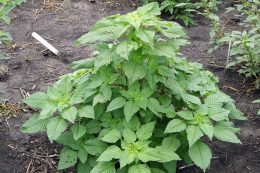Buckbrush (Symphoricarpos orbiculatus), also known as coralberry, is a native perennial shrub found in the eastern two-thirds of Kansas. The plant grows in open pastures and woodlands. It sends out “runners” and produces a red fruit in the fall. A related species, western snowberry (Symphoricarpos occidentalis), is found primarily in northcentral and northwest Kansas, and produces a white fruit.
Buckbrush is generally considered an undesirable plant in areas being grazed by cattle. Some birds and small mammals use buckbrush patches for cover and nesting. Buckbrush can form dense patches or colonies that shade out more desirable species used for grazing. Top growth removal of buckbrush after the plants have leafed out and the nonstructural carbohydrates stored in the roots are at a low level can be an effective control. One way to accomplish top growth removal is with prescribed burning. Fire can be an effective control technique if burning is done in the late spring. It may take 2 or 3 years of consecutive burning to reduce buckbrush stands. If you missed the opportunity to burn this year or are located in areas where burning wasn’t possible, mowing is an option. Again, it may take 2 or 3 years of consecutive mowing at the proper time (generally early to mid-May) to reduce stands.
Herbicides can also be used to control buckbrush. The best time to spray occurs just as the leaves are starting to change from a light to dark green color. This timing corresponds with the low point in the nonstructural carbohydrate cycle. A number of herbicides can be used to spray buckbrush, but 2,4-D low-volatile ester formulations at 1.5 to 2 lbs./acre are usually quite effective. If you are simultaneously trying to control other species, such as musk thistle, consider Chaparral (aminopyralid + metsulfuron) or Grazon P+D (picloram + 2,4-D). Chaparral can be used alone at 2 to 3 oz./acre for buckbrush control, but I prefer adding 2 pint/acre of 2,4-D to 2 oz./acre Chaparral. Grazon P+D applied at 2-3 pints/acre will provide acceptable control of both buckbrush and musk thistle. Caution should be used if treating cool-season grasses with Chaparral. Grazon P+D is a restricted use pesticide. Always read the label when considering the use of herbicides.
 Getting good control of Palmer amaranth and common waterhemp in Kansas has become more of a challenge in recent years. Many populations are now resistant to either glyphosate, triazine, ALS-inhibitor herbicides, HPPD-inhibitor herbicides, PPO-inhibitor herbicides – or a combination of those modes of action. As wheat harvest approaches over the next few weeks in Kansas, producers should plan now for good weed control ahead of double crop soybean.
Getting good control of Palmer amaranth and common waterhemp in Kansas has become more of a challenge in recent years. Many populations are now resistant to either glyphosate, triazine, ALS-inhibitor herbicides, HPPD-inhibitor herbicides, PPO-inhibitor herbicides – or a combination of those modes of action. As wheat harvest approaches over the next few weeks in Kansas, producers should plan now for good weed control ahead of double crop soybean.